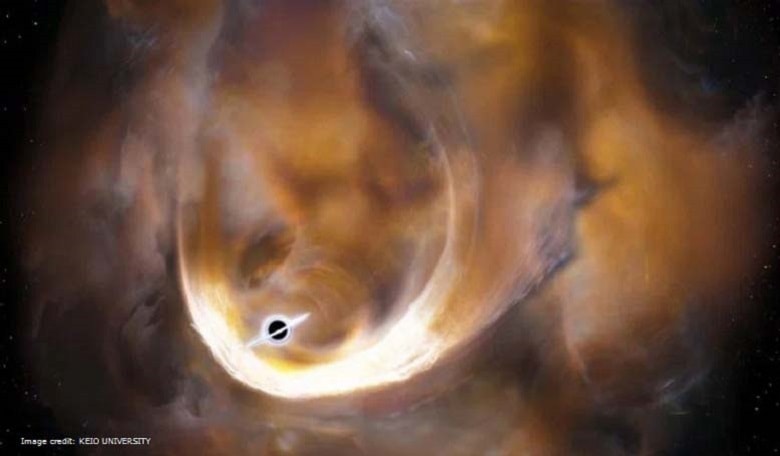Signs that a second black hole may be lurking in the Milky Way have been uncovered by a team of astronomers who have detected an enigmatic gas cloud, called CO-0.40-0.22, that is observed to have gas with a very wide range of speeds. This wide velocity dispersion is suggestive of an intermediate black hole and if this is indeed the case, it will be the first of its kind to be detected.
Using the Nobeyama 45-m Telescope in Japan and the ASTE Telescope in Chile, a team led by Tomoharu Oka, a professor at Keio University in Japan used both radio telescopes to observe this mysterious object that is only 200 light years away from the centre of the Milky Way and found that CO-0.40-0.22 consists of two components: a dense component extending 10 light years with a narrow velocity dispersion and a compact but low density component with a very wide velocity dispersion of 100 km/s.
As no holes were observed in the cloud and X-ray and infrared observations did not find any corresponding compact objects, a wide velocity dispersion caused by a local energy input, such as a supernova explosion, was ruled out. Further analysis of CO-0.40-0.22 using simulations of gas clouds attracted by a strong gravity source found that the gas would increase in velocity, reaching a maximum speed at the closest point to the object and then decreased in speed once the gas had passed the strong gravity source. The object in question that was a best fit to the data was a gravity source with 100 thousand times the mass of the Sun inside an area with a radius of 0.3 light years. “As far as we know, the best candidate for the compact massive object is a black hole,” said Oka, the lead author of the paper that appeared in the Astrophysical Journal Letters.
Black holes can be roughly categorised into two different sizes: stellar-mass black holes that are formed after the explosions of very massive stars and supermassive black holes (SMBH). SMBH are often found at the centres of galaxies and have masses that ranges from several million to billions of times the mass of the Sun. Although a number of SMBHs have been detected, it is unsure how these massive objects are formed. One possible scenario is that a “seed” black hole with tens or hundreds of solar masses at the centre of a galaxy grows by accretion of matter. Another idea is that that they are formed from mergers of many intermediate mass black holes. Many candidates for intermediate black holes have been proposed on the basis of their ultraluminous nature and lowtemperature blackbody spectral components, but to date, none have been conclusively identified. Naturally, if CO-0.40-0.22 is discovered to be an intermediate mass black hole, it might support the theory of SMBH formation via the merger of these elusive objects.
Nonetheless, despite the unconfirmed nature of CO-0.40-0.22, these results have potentially paved a new way in which to search for objects that emit little radiation in any wavelength. "Investigations of gas motion with radio telescopes may provide a complementary way to search for dark black holes" said Oka. It is suggested that there are 100 million black holes in the Milky Way Galaxy, but detecting these objects can be difficult. "The on-going wide area survey observations of the Milky Way with the Nobeyama 45-m Telescope and high-resolution observations of nearby galaxies using the Atacama Large Millimeter/submillimeter Array (ALMA) have the potential to increase the number of black hole candidates dramatically." As recent observations have revealed that there are a number of wide-velocity-dispersion compact clouds similar to CO-0.40-0.22, it is possible that some of those clouds might contain black holes. Soon researchers might be able to tell just what makes a super massive black hole, super massive.











